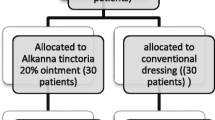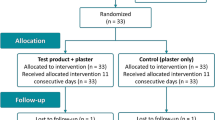Abstract
Poor wound healing remains a critical problem in our daily practice of surgery, exerting a heavy toll on our patients as well as on the health care system. In susceptible individuals, scars can become raised, reddish, and rigid, may cause itching and pain, and might even lead to serious cosmetic and functional problems. Hypertrophic scars do not occur spontaneously in animals, which explains the lack of experimental models for the study of pathologic scar modulation. We present the results of three clinical comparative prospective studies that we have conducted. In the first study, secondary healing and cosmetic appearance following healing of partial thickness skin graft donor sites under dry (semi-open Sofra-Tulle dressing) and moist (moist exposed burn ointment, MEBO) was assessed. In the second study, healing of the donor sites was evaluated following treatment with Tegaderm or MEBO, two different types of moisture-retentive dressings. In the third study, 3 comparable groups of primarily healed wounds were evaluated. One group was treated by topical antibiotic ointment, the second group was treated by Moist Exposed Burn Ointment (MEBO), and the third group did not receive any topical treatment. In the second study, secondary healing of partial thickness skin graft donor sites was evaluated following treatment with Tegaderm or MEBO, two different types of moisture-retentive dressings. In the second and third studies, healed wounds were evaluated with the quantitative scale for scar assessment described by Beausang et al. [1] Statistical analysis revealed that for both types of wound healing, scar quality was significantly superior in those wounds treated with MEBO.
Similar content being viewed by others
References
E Beausang H Floyd KW Dunn GI Orton et al. (1998) ArticleTitleA new quantitative scale for clinical scar assessment. Plast Reconstr Surg 102 1954 Occurrence Handle1:STN:280:DyaK1M%2FislWitA%3D%3D Occurrence Handle9810991
KI Cohen (2000) ArticleTitleThe biology of wound healing. Contemp Surg (Suppl) Sept 4 . .
F Grinnel (1994) ArticleTitleFibroblasts, myofibroblasts, and wound contraction. J Cell Biol 124 401 Occurrence Handle1:CAS:528:DyaK2cXhtlSqsLs%3D Occurrence Handle8106541
KI Cohen RF Diegelmann DR Yager IL Wornum III (1999) Principles of Surgery, 7th ed. Schwartz, International Edition. S Spencer DF Galloway (Eds) Wound Care and Wound Healing. McGraw-Hill New York 269–290
EE Peacock (1984) Wound Repair (3rd ed) W.B. Saunders Philadelphia
BA Mast (1992) Repair of specific tissues: The skin. RF Diegelman WJ Lindblad (Eds) Wound Healing: Biochemical and Clinical Aspects, IK W.B. Saunders Philadelphia 344–355
FB Niessen PHM Spauwen PH Robinson et al. (1998) ArticleTitleThe use of silione occlusive sheeting (Sil-K) and silicone occlusive gel (Epiderm) in the prevention of hypertrophic scar formation. Plast Reconstr Surg 102 1962 Occurrence Handle1:STN:280:DyaK1M%2FislWitQ%3D%3D Occurrence Handle9810992
ST Ahn WW Monafo TA Mustoe (1991) ArticleTitleTopical silicone gel for the prevention and treatment of hypertrophic scar. Arch Surg 126 499 Occurrence Handle1:STN:280:By6C1c7pvFM%3D Occurrence Handle2009067
E Peacock (1984) Wound Repair, 2nd ed. W Saunders Philadelphia 485–503
G Magliacani M Stella C Costagliola et al. (1997) ArticleTitlePost-burn pathologic scar: Clinical aspects and therapeutic approach. Ann Burn Fire Disasters 10 105
JC Murray (1993) ArticleTitleScars and keloids. Dermatol Clin 11 697 Occurrence Handle1:STN:280:ByuD3sjms1A%3D Occurrence Handle8222353
KI Cohen (2000) ArticleTitleWound healing: Key advances in research and clinical care. Contemp Surg (Suppl) Sept 2 . .
JB McCraw JA McCraw A McMellin N Bettencourt (1999) ArticleTitlePrevention of unfavorable scars using early pulse dye laser treatments: A preliminary report. Ann Plast Surg 42 7
E Muti E Ponzio (1983) ArticleTitleCryotherapy in the treatment of keloids. Ann Plast surg 11 227 Occurrence Handle1:STN:280:BiuD2M%2FnsFM%3D Occurrence Handle6638822
M Garcia-Velasco R Ley D Mutch N Surkes HB Williams (1978) ArticleTitleCompression treatment of hypertrophic scars in burned patients. Can J Surg 21 450 Occurrence Handle1:STN:280:CSaD28zlt1E%3D Occurrence Handle719572
DA Sherris WF Larrabee Jr CS Murakami (1995) ArticleTitleManagement of scar contractures, hypertrophic scars, and keloids. Otolaryngol Clin North Am 28 1057
DL Larson . Abston EB Evans M Dorbkovsky HA Linares (1971) ArticleTitleTechniques for decreasing scar formation and contractures in the burned patient. J Trauma 11 807 Occurrence Handle1:STN:280:CS2D3cvks1E%3D Occurrence Handle4937679
MH Gold (1994) ArticleTitleA controlled clinical trial of topical silicone gel sheeting in the treatment of hypertrophic scars and keloids. J Am Acad Dermatol 30 506 Occurrence Handle1:STN:280:ByuC2Mjhs10%3D Occurrence Handle8113473
T Krusche WI Worret (1995) ArticleTitleMechanical properties of keloids in vivo during treatment with intralesional triamcinolone acetonide. Arch Dermatol Res 287 289 Occurrence Handle1:STN:280:ByqA387nsFI%3D Occurrence Handle7598534
WF Larabee Jr CA East HS Jaffe C Stephenson KE Peterson (1990) ArticleTitleIntralesional interferon gamma treatment for keloids and hypertrophic scars. Arch Otolaryngol Head Neck Surg 116 1159 Occurrence Handle2119626
WT Lawrence (1991) ArticleTitleIn search of the optimal treatment of keloids: Report of a series and a review of the literature. Ann Plast Surg 27 164 Occurrence Handle1:STN:280:By2D28%2FnvFc%3D Occurrence Handle1835334
JA Carr-Colloins (1992) ArticleTitlePressure techniques for the prevention of hypertrophic scar. Clin plast Surg 19 733
T Svensjo B Pomahac F Yao J Slama et al. (2000) ArticleTitleAccelerated healing of full-thickness skin wounds in a wet environment. Plast Reconstr Surg 106 663
E Erikson N Perez J Slama CP Page et al. (1996) ArticleTitleTreatment of chronic, nonhealing abdominal wound in a liquid environment. Ann Plast Surg 36 80 Occurrence Handle8722990
K Breuing E Erikson P Liu DR Miller (1992) ArticleTitleHealing of partial thickness porcine skin wounds in a liquid environment. L Surg Res 52 50 Occurrence Handle1:STN:280:By2C1MvntF0%3D
M Dyson S Young L Pendle DF Webster et al. (1988) ArticleTitleComparison of the effects of moist and dry conditions on dermal repair. J Invest Dermatol 91 434
PM Vogt C Andree K Breuing PY Liu et al. (1995) ArticleTitleDry, moist, and wet skin wound repair. Ann Plast Surg 34 493 Occurrence Handle1:STN:280:ByqA28nnt1E%3D Occurrence Handle7639486
BS Atiyeh G Ghanimeh IL Kaddoura C Al Amm J Ioannovich (2001) ArticleTitleSplit thickness skin graft donor site dressing: Preliminary results of controlled clinical comparative study of MEBO and Sofra-Tulle. Ann Plast Surg 46 87 Occurrence Handle1:STN:280:DC%2BD3M3htFCjug%3D%3D Occurrence Handle11192048
BS Atiyeh J Ioannovich CA Al Amm (2000) ArticleTitlePansements de sites donneurs De greffe de peau mince: Resultats preliminaires d’une etude clinique limitee comparative de “MEBO” et de “Sofra-Tulle”. Brulures, Revue Francçaise de Brûlologie 1 155
BS Atiyeh CA Al-Amm AA Nasser (2002) ArticleTitleImproved healing of split thickness skin graft donor sites. J Applied Res 2 114–121
BS Atiyeh CA Al-Amm KA El-Musa A Sawwaf R Dham (2003) ArticleTitleScar quality and physiologic barrier function restoration following moist and moist exposed dressings of partial thickness wounds. Dermatol Surg 29 14 Occurrence Handle10.1046/j.1524-4725.2003.29002.x Occurrence Handle12534506
BS Atiyeh J Ioannovich CA Al-Amm KA El-Musa R Dham (2002) ArticleTitleImproving scar quality: A prospective clinical study. Aesth Plast Surg 26 470 Occurrence Handle10.1007/s00266-002-2019-5
L Feldman (1991) ArticleTitleWhich dressing for split-thickness skin graft donor sites? Ann Plast Surg 27 288 Occurrence Handle1:STN:280:By2D28%2FotFA%3D Occurrence Handle1952757
D Feldman A Rogers R Karpinski (1991) ArticleTitleA prospective trial comparing Biobrane, Duoderm and Xeroform for skin graft donor sites. Surg Gyn Obstet 173 1 Occurrence Handle1:STN:280:By6A38jisFw%3D
P Vanstraelen (1992) ArticleTitleComparison of calcium sodium alginate (KALTOSTAT) and porcine xenograft (E-Z DERM) in the healing of split-thickness skin graft donor sites. Burns 18 145 Occurrence Handle1:STN:280:By2B2s3ps1U%3D Occurrence Handle1590931
P Kelton Jr (1992) ArticleTitleSkin grafts. Selec Read Plast Surg 7 IssueID2 1
AJ Nemeth (1991) ArticleTitleFaster healing and less pain in skin biopsy sites treated with an occlusive dressing. Arch Dermatol 127 1679 Occurrence Handle1:STN:280:By2D287gvF0%3D Occurrence Handle1952972
Y Sawada T Yotsuyanagi K Sone (1990) ArticleTitleA silicone gel sheet dressing containing an antimicrobial agent for split thickness donor site wounds. Br J Plast Surg 43 88
GD Winter JT Scales (1963) ArticleTitleEffect of air drying and dressings on the surface of a wound. Nature 197 91 Occurrence Handle1:STN:280:CC2C1MzhtlA%3D
R Xu (1989) ArticleTitleThe medicine of burns and ulcers, a general introduction. Chinese J Burns Wounds Surf Ulcers . IssueID1 68
IK Cohen BJ McCoy (1990) ArticleTitleThe biology and control of surface overhealing. World J Surg 4 289
EE Peacock (1981) ArticleTitlePharmacologic control of surface scarring in human beings. Ann Surg 193 592 Occurrence Handle7235764
BM Topol VL Lewis K Benvensite (1981) ArticleTitleThe use of antihistamine to retard growth of fibroblasts derived from human skin, scar and keloid. Plast Reconstr Surg 38 227
Acknowledgements
This paper was presented at the XVI Congress of ISAPS, Istanbul, Turkey, 26–29 May 2002.
Author information
Authors and Affiliations
Corresponding author
Rights and permissions
About this article
Cite this article
Atiyeh, B.S., Amm, C.A. & El Musa, K.A. Improved Scar Quality Following Primary and Secondary Healing of Cutaneous Wounds . Aesth. Plast. Surg. 27, 411–417 (2003). https://doi.org/10.1007/s00266-003-3049-3
Accepted:
Published:
Issue Date:
DOI: https://doi.org/10.1007/s00266-003-3049-3




